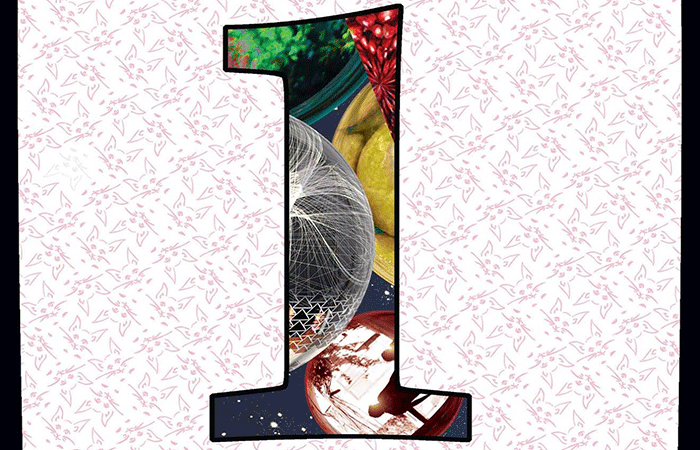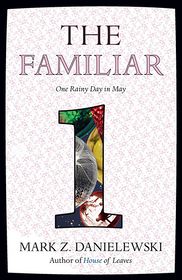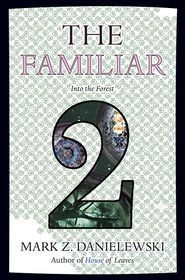Decoding the Storm: Mark Z. Danielewski’s The Familiar, Volume 1
 If dictionaries consisted of complete phrases, and if in that special dictionary you were to look up “humongously complex magnum opus of epic proportions” you would most certainly find Mark Z. Danielewski’s The Familiar. A proposed 27 volume masterwork, it begins with a heavy opening salvo in The Familiar, Volume 1: One Rainy Day in May, which at nearly 900 pages, seems to barely scrape the surface of whatever elaborate overarching narrative is to come.
If dictionaries consisted of complete phrases, and if in that special dictionary you were to look up “humongously complex magnum opus of epic proportions” you would most certainly find Mark Z. Danielewski’s The Familiar. A proposed 27 volume masterwork, it begins with a heavy opening salvo in The Familiar, Volume 1: One Rainy Day in May, which at nearly 900 pages, seems to barely scrape the surface of whatever elaborate overarching narrative is to come.
The Familiar, Volume 1: One Rainy Day in May
The Familiar, Volume 1: One Rainy Day in May
Paperback $28.95
To be fair, anyone who has read Danielewski—most notably the unnerving House of Leaves—knows that 900 pages of Danielewski isn’t the same thing as 900 pages of your garden variety gonzo thriller. Rather than filling each page with, you know, words, his works are as much novels as they are experiments in elaborate typography and visual design, with pages often left blank, or printed with only a single sentence, or one lonely word. That’s not to say they are breezy, easy reads: The Familiar, Volume 1 is a massive puzzle box, an invitation to explore, a challenge to forget and re-learn everything you know about the simple act of reading. Danielewski treats the traditional universe of pages between two covers as something liquid and alien, a perpetually fluctuating palette (over 20 different fonts, margin scribbles, random notations, cryptic codes) that undulates and slithers along its own unconventional axis.
In other words: there is no narrative spoon-feeding here, folks. You are going to have to work at it. And even then, you might be come up short. I don’t claim to have all the answers. Far from it, actually. I’m not even sure I have some of the answers, because whatever I think I know now only seems to lead to more questions. It’s sort of like watching six seasons of Lost at the same time, though I suspect Danielewski is not making it up as he goes along.
Here’s what I do know: The Familiar, Volume 1 follows nine main characters, none of whose storylines are initially connected. Or are they? Much of the book involves a 12-year-old girl named Xanther and her family in Los Angeles, where her father is involved in developing a revolutionary gaming engine and her therapist-in-training mother wants desperately to keep her daughter safe. There’s also a dangerous East L.A. gang member with a penchant for violence, a pair of scientists in west Texas struggling to keep a great secret from being revealed, and a former drug addict in Singapore given a rare opportunity by a wealthy benefactor.
To be fair, anyone who has read Danielewski—most notably the unnerving House of Leaves—knows that 900 pages of Danielewski isn’t the same thing as 900 pages of your garden variety gonzo thriller. Rather than filling each page with, you know, words, his works are as much novels as they are experiments in elaborate typography and visual design, with pages often left blank, or printed with only a single sentence, or one lonely word. That’s not to say they are breezy, easy reads: The Familiar, Volume 1 is a massive puzzle box, an invitation to explore, a challenge to forget and re-learn everything you know about the simple act of reading. Danielewski treats the traditional universe of pages between two covers as something liquid and alien, a perpetually fluctuating palette (over 20 different fonts, margin scribbles, random notations, cryptic codes) that undulates and slithers along its own unconventional axis.
In other words: there is no narrative spoon-feeding here, folks. You are going to have to work at it. And even then, you might be come up short. I don’t claim to have all the answers. Far from it, actually. I’m not even sure I have some of the answers, because whatever I think I know now only seems to lead to more questions. It’s sort of like watching six seasons of Lost at the same time, though I suspect Danielewski is not making it up as he goes along.
Here’s what I do know: The Familiar, Volume 1 follows nine main characters, none of whose storylines are initially connected. Or are they? Much of the book involves a 12-year-old girl named Xanther and her family in Los Angeles, where her father is involved in developing a revolutionary gaming engine and her therapist-in-training mother wants desperately to keep her daughter safe. There’s also a dangerous East L.A. gang member with a penchant for violence, a pair of scientists in west Texas struggling to keep a great secret from being revealed, and a former drug addict in Singapore given a rare opportunity by a wealthy benefactor.
The Familiar, Volume 2: Into the Forest
The Familiar, Volume 2: Into the Forest
In Stock Online
Paperback $25.00
As Danielewski alternates between these characters and others, chapter-by-exponentially-more-cryptic-chapter, the book’s very feel and appearance changes too. Font size and typeface vary dramatically by individual, becoming easily identifiable as each character’s distinct voice. Words and conversations are presented using parentheses and brackets to mirror computer code, or phrases suddenly swirl off the page in widening circles, or dialogue is written in a nearly unintelligible fragmented English. Yet there is more going on here than experimental typography, because Danielewski imbues book with an raw intelligence, luring curious readers to connect the dots. It’s more than a gimmick; it’s an interlocking storytelling experiment augmented by a treasure map of clues and hints, of which all, some, or none may be relevant. With 26 more volumes to come—a new one to be released every few months—it is impossible to say how much is important now, or what will be key later.
There’s a quote I have always liked, attributed to Martin Mull, that proclaims, “writing about music is like dancing about architecture.” Well, writing about The Familiar is like that too. From a 30,000-foot-view, you can attempt to parcel out the basics of the plot and characters, but that pales to the experience of wading into its depths. That would be like using cheat codes to make it through a video game—you’ll get to see what happens, but you’ll have seriously blunted the impact of the journey to get there.
Danielewski hasn’t just written a book, he has crafted a piece of bound, physical art you can hold and study. He is daring adventurous, attentive readers to embark on a quest that will demand much of them: discussion, analysis, and interpretation. Are you up for it?
The Familiar, Volume 1 is available now. The Familiar, Volume 2: Into the Forest will release October 27.
As Danielewski alternates between these characters and others, chapter-by-exponentially-more-cryptic-chapter, the book’s very feel and appearance changes too. Font size and typeface vary dramatically by individual, becoming easily identifiable as each character’s distinct voice. Words and conversations are presented using parentheses and brackets to mirror computer code, or phrases suddenly swirl off the page in widening circles, or dialogue is written in a nearly unintelligible fragmented English. Yet there is more going on here than experimental typography, because Danielewski imbues book with an raw intelligence, luring curious readers to connect the dots. It’s more than a gimmick; it’s an interlocking storytelling experiment augmented by a treasure map of clues and hints, of which all, some, or none may be relevant. With 26 more volumes to come—a new one to be released every few months—it is impossible to say how much is important now, or what will be key later.
There’s a quote I have always liked, attributed to Martin Mull, that proclaims, “writing about music is like dancing about architecture.” Well, writing about The Familiar is like that too. From a 30,000-foot-view, you can attempt to parcel out the basics of the plot and characters, but that pales to the experience of wading into its depths. That would be like using cheat codes to make it through a video game—you’ll get to see what happens, but you’ll have seriously blunted the impact of the journey to get there.
Danielewski hasn’t just written a book, he has crafted a piece of bound, physical art you can hold and study. He is daring adventurous, attentive readers to embark on a quest that will demand much of them: discussion, analysis, and interpretation. Are you up for it?
The Familiar, Volume 1 is available now. The Familiar, Volume 2: Into the Forest will release October 27.

